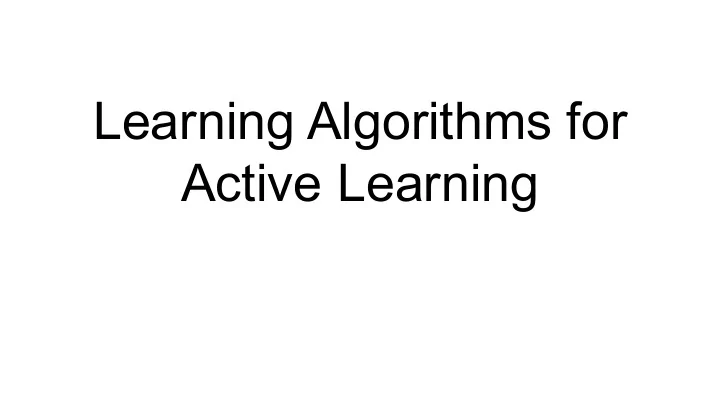

Learning Algorithms for Active Learning
Plan ● Background ○ Matching Networks ○ Active Learning ● Model ● Applications: Omniglot and MovieLens ● Critique and discussion
Background: Matching Networks (Vinyals et al. 2016) embedding embedding of example of probe item label of cosine example distance (e.g.)
Background: Matching Networks
Background: Matching Networks Bidirectional LSTM
Background: Matching Networks
Background: Active Learning ● Most real-world settings: many unlabeled examples, few labeled ones ● Active Learning : Model requests labels; tries to maximize both task performance and data efficiency ○ E.g. task involving medical imaging: radiologist can label scans by hand, but it’s costly ● Instead of using heuristics to select items for which to request labels, Bachman et al. use meta learning to learn an active learning strategy for a given task
Proposed Model: “Active MN”
Individual Modules Context Free and Sensitive Encodings ● Gain context by using a bi-directional LSTM over independent encodings Selection u over all unlabeled items in S t u ● At each step t, places a distribution P t u computed using a gated, linear combination of features that measure controller-item and ● P t item-item similarity Reading ● Concatenates embedding and label for item selected, then applies linear transformation Controller ● Input: r t from reading module, and applies LSTM update:
Prediction Rewards Prediction Reward: Objective: Fast Prediction ● Attention-based prediction for each unlabeled item using cosine sim. to labeled items u and the control state ○ Sharpened by a non-negative matching score between x i ● Similarities between context-sensitive embeddings don’t change with t -> can be precomputed Slow Prediction ● Modified Matching Network prediction ○ Takes into account distinction between labeled and unlabeled items ○ Conditions on active learning control state
Full Algorithm
Tasks Goal: maximize some combination of task performance and data efficiency Test model on: ● Omniglot ○ 1623 characters from 50 different alphabets ● MovieLens (bootstrapping a recommender system) ○ 20M ratings on 27K movies by 138K users
Experimental Evaluation: Omniglot Baseline Models 1. Matching Net (random) a. Choose samples randomly 2. Matching Net (balanced) a. Ensure class balance 3. Minimum-Maximum Cosine Similarity a. Choose items that are different
Experimental Evaluation: Omniglot Performance
Experimental Evaluation: Data Efficiency Omniglot Performance MovieLens Performance
Conclusion Introduced model that learns active learning algorithms end-to-end. ● Approaches optimistic performance estimate on Omniglot ● Outperforms baselines on MovieLens
Critique/Discussion Points examples probe ● Controller doesn’t condition its label requests on the probe item Image source: https://en.wikipedia.org/wiki/File:Marmot-edit1.jpg,
Critique/Discussion Points examples probe ● Controller doesn’t condition its label requests on the probe item ● In Matching Networks, the embeddings of the examples don’t depend on the probe item Image source: https://en.wikipedia.org/wiki/File:Marmot-edit1.jpg,
Critique/Discussion Points ● Active learning is useful in settings where data is expensive to label, but meta-learned active learning requires lots of labeled data for training, even if this labeled data is spread across tasks. Can you think of domains where this is / is not a realistic scenario?
Critique/Discussion Points ● Active learning is useful in settings where data is expensive to label, but meta-learned active learning requires lots of labeled data for training, even if this labeled data is spread across tasks. Can you think of domains where this is / is not a realistic scenario? ● In their ablation studies, they observed that taking out the context-sensitive encoder had no significant effect. Are there are applications where you think this encoder could be essential? ● In this work, they didn’t experiment with NLP tasks. Are there any NLP tasks you think this approach could help with?
Recommend
More recommend